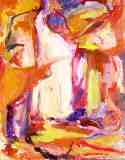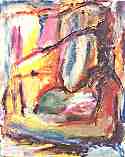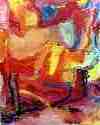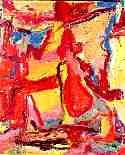Paintings and Commentary By Joyce Sampson
 Joyce Sampson: "1998-1"
Joyce Sampson: "1998-1"

Joyce Sampson: "1998-2"

Joyce Sampson: "1998-3"

Joyce Sampson: "1998-4"
During the war he was stationed (in the Army) at the far end of Long Island and had hitchhiked to Manhattan every weekend to study with Hofmann. After the war, Carone went to Rome. He had a one-mans show there in 1948. He received a Fulbright in 1949 for the Rome Academy, then remained in Rome three more years. During these times he worked out his own personal Abstract Expressionist style. He showed in Rome, Paris, and Tokyo. His work was in the 1956 Venice Biennale and the 1958 Brussels Fair. When I was first studying with him he was showing uptown at the Stable Gallery and later at the Staempfli Gallery on Madison Avenue.
At the end of my Cooper Union draw class, a group of interested students "hired" him to teach us "more", in a loft space available to us free. Additional Carone classes were added on in ensuing years, other students joined us. As with Hofmann students, the more advanced students "explained" to the beginners what he had said. We ended in a cheap loft space, at 14th Street and 6th Avenue which Carone and two other teachers used to teach private classes.
Carone's class met on Sundays, the only night free for those still in school. The other teachers dropped out and we expanded to four nights of open drawing from the model. Bob Sievert and I drew free on the open sketch nights and I in Carone's classes. As all kinds of other work, happenings, Pop, Op, Minimal, conceptual, passed by, we continued on attracting people who wanted to draw from the model. We also organized "Saturday Specials" of one or two weeks of six hours of the same pose for painting, and also six hours of two models.
During the period of the 14th Street Drawing Studio I had the opportunity to try out many permutations of styles and media. Whatever resultant work came out, there was always plastic space, cubic space as defined by Hofmann and Carone.
Once I experienced using the possibilities inherent in seeing and working with cubic space, negative space, push and pull, shifting and moving to create a more dynamic and exciting picture plane, I could leave behing such things I had learned, but was not interested in, as perspective, light and shadow, etc., and start looking for ways to express my own visual experience and creative reaction. I could never go back (unless I wanted to, temporarily) to standard paintings. Nor could I alter my work to suit the ongoing latest "in" ways to paint.
About Hofmann's Paintings
When I look at Hofmann's paintings, what I see is the spaces and how they interweave and set up tension and motion. Carone said that Hofmann, discussing cool and warm colors, said: "I can put any color anywhere I want to." In Hofmann's late paintings, some made up of blocks of color, I see a green, which is supposed to recede as a "cool" color, standing right out in front of a huge red area, clearly placed behind it (although red is a "hot" color and supposed to come forward. Each time I have visited the Metropolitan Museum of Art Hofmann show, I see more and more intensive, extensive work behind what seemed to be fairly simple painting. I was newly refreshed by all that I saw in these late works. My recent work has been reaffirmed as relevant. I am part of that long line of art Hofmann traced back to Cimabue, up through Cézanne and the early modern painters, to him, to his students, then to me.
My Paintings
In the earlyu 1970's I was making realistic landscape oil paintings in Pennsylvania. I painted the trees, the streams and river, with reflections, and the fields and farms, often with the Appalachian Mountains in the background. I was using realistic colors but the elements of my earlier work using plastic space, negative space, etc., learned from Carone, were always present. I was painting like this until the Fauve show of 1991, at the Metropolitan Museum. This show inspired me to use bolder colors: bright reds, yellows, pinks, oranges, and purples. At this time, the possibility occurred to me that I could use my woods to make bright colorful abstract paintings. I used oil crayons and worked on plate-finish vellum paper.
The first ones were fairly simple. They also looked like interiors and reminded me of my work done years ago during my Cooper Union Grand Canyon painting trips, which also looked like interiors.
The paintings shown here are recent attempts to depict plastic space, shifting planes and forms which I found in the woods, trees, weeds and rocks near my Pennsylvania house I paint outdoors and look into a 5' x 20' stretch of the woods. This is my current "motif" as in Cezanne. I paint many different works in many different seasons from the same view up through the woods. From just using a single position I can collect and select and make many different works I employ all the knowledge learned a long time ago about plastic space, positive and negative space, selection, deletion shifting color and forms around; a delightful, mind boggling, endless pursuit I am never totally satisfied with an end product. I start anew on another canvas. Of coarse you never get it as you meant to, so you push on and try again. There is no actual end. It is the process that counts. The endless search and struggle is the end, but like a snake with its tail in its mouth, you find at the end you encounter the gift of a new beginning.